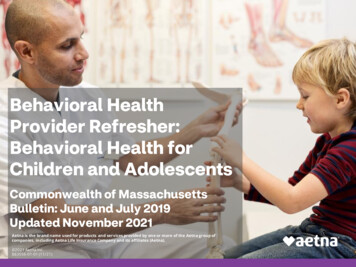
Transcription
SMART CHANGE STARTS HEREPSYCHOGRAPHIC TARGETING ANDBEHAVIORAL TARGETINGBY HEIDI TOLLIVER-WALKER
When it comes to understanding yourcustomers and prospects, demographicdata is critical. But is it enough?Demographic targeting tells you whatsomeone looks like, but it does not predictwhat they will buy or what type of messagingis most effective in reaching them. For this,marketers must turn to behavioral andpsychographic targeting.Let’s look at the differences between demographic,behavioral, and psychographic targeting.Demographic targeting is based on the projected needs ofindividual buyers or groups of buyers based on their objectiveattributes, such as age, gender, and household income.Behavioral targeting looks at what people are likely to buy(or what they need to move them along the sales funnel)based on what they do. When they’re online, what pagesdo they visit? How long do they spend there? What piecesof content do they download?Psychographic targeting crafts strategies and messagingbased on how people think. What do they like? What’simportant to them? What other characteristics, such ashobbies and TV watching habits, give you deeper insightinto what they need and motivates them to buy?Behavioral and psychographic targeting don’t replacedemographic targeting—they complement it. Each has itsrole in developing and informing your marketing strategy.2
WHY PSYCHOGRAPHIC TARGETING MATTERSTo further understand the difference between these forms of targeting, let’s look at how HubSpot, a multichannel marketingand content marketing platform, contrasts demographic from psychographic targeting in relation to a hypothetical female buyer:Demographic ProfilePsychographic ProfileFemaleConcerned with health and appearanceAged 45-65Wants a healthy lifestyle, but doesn’t have much timeMarried, with childrenTends to favor quality over economyDealing with issues of weight gain, diabetes,lack of energy or hormonal imbalanceEnjoys going online in the evenings, big fan of PinterestHousehold income 100K Finds fulfillment in her career and familyThese are two entirely different ways of understanding thisprospective buyer. The first tells you what she (or a groupof buyers like her) “looks” like. The second tells you howshe thinks and what motivates her.isn’t going to move her. Instead, she wants to hear that yournutritional counseling service has worked for others and howit will give her better health without a huge time commitment.So, make sure you highlight customer comments to thateffect. When you know that she’s spending her free timeon Pinterest, you can stop spending money on Facebookor newspaper and magazine ads. Instead, use her love ofPinterest and share time-saving household and nutrition tipsand give her ideas for fun things to do with family and friends.*How would you use this information? HubSpot gives thefollowing analysis:Once you understand what’s important to her, you’ll knowwhere to find her and how to motivate her. You’ll know howto give her what she wants — that offering deep discounts* graphics3
DO YOU ALWAYS NEED PSYCHOGRAPHICS?Does this mean that you always need psychographicinformation to motivate buyers? No. For example, you don’tneed psychographics to know that a recent college graduateis likely to need a new wardrobe before starting his or her newjob, or that a family just introducing its third child might be inthe market for a minivan. In categories like these, demographicinformation might be all you need.This is an extreme example, but it makes an important point.Just because people are demographically similar doesn'tmean you should market to them the same way.Application Tip:Say you’re a vision center ordering new in-storesignage. Use psychographics to create differentposters and displays that appeal to variedpsychographic segments. One poster might targetthe “trendsetter” by emphasizing that you offereyeglasses on the cutting-edge of fashion. Anotherposter might target practical, non-risk-takers bydetailing your store hours, optical services, and“best-in-class” warranty. This allows you to marketto people who look demographically similar butfor whom buying decisions are based on verydifferent priorities.But demographics have their limitations. Even whenthe demographics of certain individuals looks identical,their personalities, priorities, and motivators can beentirely different.For example, take two adult men. Both are around 70 years old.Both have college degrees, are millionaires, and are divorced.Both love to travel. Demographically, they’re very similar and,from a demographic targeting perspective, you might treatthem the same. Pull back the curtain to reveal their identities,however, and you’ll see that demographics tell you very little, ifanything, about who they are or what they need.Psychographics play an important role in identifying marketsas well. Take hybrid cars. Your target audience may sharebroad demographic traits, such as level of education orhousehold income. However, their personal values, asreflected in things such as social media activity (e.g., liking“bike to work” posts), purchase history, and web browsingand Internet search activity, would be better predictorsof the likelihood of buying a hybrid car.Source: Comparison originally drawn by InfusionSoft4
GETTING STARTEDHow do you get started in psychographic and behavioraltargeting? You can’t just go out and buy psychographics theway you do demographic data . . . or can you? Yes, you can.You can purchase psychographic and behavioral data, andyou can develop your own. It’s not as straightforward asdemographic targeting, but it’s not all that different onceyou get your head around it.You can also purchase psychographic profiles from thirdparty research firms that have done this work for you.Cambridge Analytica, for example, now widely known for itshighly successful psychographic targeting in the 2016 U.S.election, claims to have 4,000 – 5,000 pieces of data on everyperson living in the United States. It uses this data to createand sell psychographic profiles. Smaller companies, such asInfusionSoft, can help companies get started at a smaller level.Behavioral targeting is largely accomplished by tracking onlinebehavior via cookies. There are a multitude of third-partysolutions to help marketers understand the “who,” “what,”and “where” of what their customers and site visitors aredoing on the web.Application Tip:Say you’re a cosmetics company launching a newline of mascara. You send out three versions of yourproduct announcement. The first targets buyers withthe “social consciousness” profile by marketing theproduct as vegan and 100% cruelty-free. You alsowoo them by informing them that a portion of theprofits from the sale is donated to their local animalshelter. The second targets the “fashionista” profile bypositioning the product as a cost-effective alternativeto lash extensions. The third targets the “practical,cost-conscious” buyer by focusing on the low price andoffering “buy one, get one free.” As consumers respondto different offers, you assign them the profileassociated with that offer and use that informationto guide your future communications.Psychological targeting can be more complex, but that doesn’thave to mean it’s out of reach. You can purchase lists ofconsumers that fall into different psychographic groups asdetermined by third-party data firms. You can also do yourown psychographic profiling based on data, including (butnot limited to) . . . R esults of customer surveys/focus groups P urchase history S ocial media activity I nternet browsing history R etargeting behaviorFor online customers, you can layer in even more detail byusing keyword research to see what searches buyers wereconducting before they made a purchase. And you cangather additional detail from social media conversationsand customer reviews.5
USING PSYCHOGRAPHICS ON THE GROUND W hat were the most important factors in selectingthe pillows that you did?What might this look like on the ground? Let’s say you sellhome decorating items, such as wall décor, candles, and throwpillows. You feel that the throw pillow market is explodingand want to make a heavier investment in these products.However, you also know that your next buyer is as likely to bea 25-year-old woman living in Wyoming as she is a 65-year-oldwoman living in Maine. Since demographics aren’t going to beof much help, psychographics can play an important role.You can also ask lifestyle questions to learn even more aboutthese buyers. What do they do in their free time? What mattersto them most? What are their hobbies, television watchinghabits, and religious or political views? Once you have thisinformation, then you can start your analysis. How do peoplebuying pillows for practical reasons differ from people buyingpillows as gifts? Are there common threads among peoplein life transition? How about clues from their lifestyles? Forexample, are people who like gardening more likely to buypillows with sayings than pillows with decorator fabric?First, we start by identifying the primary reasons a shoppermight purchase throw pillows. For example . . . Her couch is starting to wear; throw pillows will addcomfort and cover up imperfections. Her decorating style has changed and now she’s redoingthe look of her home.You could spend days and weeks analyzing the data andcoming up with connections that help you develop marketingstrategies not just based on what people buy, but why. Her family bought a new couch and love seat and shedoesn’t like the ones that come standard with the set. She’s going through a life change and wants pillowsto make a statement about who she is.Application Tip:Do you know which ones are gift givers? If so, whynot send emails around gift-giving holidays, such asMother’s Day? How about people with a passion forhome decorating? For these, why not incorporatedecorating ideas into your blog posts, with purchaselinks to products mentioned in the posts? Or youcould take the people who said they were the mostlikely to recommend your products to others andinvite them to participate on a research panel thatgives them sneak peeks and input into upcomingproducts. This not only maintains engagement,including among future customers, but it also createsbrand ambassadors. Her friend just purchased a new home and she needsa housewarming gift.The next step is to learn more about why these shoppersmake the specific purchasing decisions they do. One way issimply to ask them. Conduct a survey of recent customers.For example, you might ask . . . When was the last time you purchased throw pillows? Why did you purchase throw pillows? Were the pillows a spontaneous purchase or planned? H ow important are throw pillows to your décor? N ow that you own throw pillows, are you using themdifferently than you intended when you bought them?If so, how?6
OCEAN MODELSAnother way marketers use psychographics is to understandnot just what aspects of products and services motivatebuyers most, but how to speak to buyers in ways that aremost likely to get them to buy.Of course, you can create your own psychographic profiles,too. Porsche, for example, has created the following profiles:While marketers use many different psychographic profiles(and many marketers develop their own), one of the mostcommonly used is the OCEAN model. While it’s not the onlyway to look at personality characteristics, we’ll use it forthe sake of discussion here.The elitist: Individual from old money who has theattitude that a car is just a vehicle and not an expressionof a person’s personality.OCEAN is an acronym that stands for the following:Bon vivants: Thrill seekers and jetsetters who seea Porsche as a means of excitement.OOpennessCTendency toward orderConscientiousnessand planningEExtraversionTendency to be socially mindedAAgreeablenessTendency to put the needsof others before their ownNNeuroticismTendency to worryTop gun: Ambitious and driven individual who cares aboutpower and control, expecting to be noticed.Proud patrons: People who see a Porsche as a trophyand consider it to be a reward for hard work.Openness to new experiencesFantasist: People who see a Porsche as a form ofescape but do not care about impressing others.*Because Porsche is looking to increase purchases fromwomen and younger consumers, it’s added another profileconsisting of people “enjoying a sporty vehicle for daily useby women and younger drivers.” This profile is reflected in itsmarketing campaign, “Engineered for magic, every day.”How might this model be put to work? Say you have two men,Bob and Steve. Both share the following demographic profile:Application Tip:One way to make use of personality categories isorganizing the material on your website. Say you’rea florist. Instead of organizing floral arrangementsby type or even occasion, you might organizethem according to buyer personality: “Flowersfor Everyone” (Safe and Steady, Non-Risk Taker),“Delicate Petals” (Very Feminine), or “Arrangementson the Edge” (Risk-takers). Each category mightinclude some of the same arrangements, but whenpeople choose to purchase under a specific categoryheading, they self-select as falling into the personalityprofile associated with that category. Futurecommunications can then include language thatreflects the profile. For risk-takers, you might say,“When was the last time your loved one received anarrangement like this?” while the non-risk taker wouldreceive, “Here’s a gift sure to satisfy every taste.”40 - 45 years oldMarriedHas childrenMid-incomeCapital One userUSA Today readerWhile both Bob and Steve might look the samedemographically, they might be very different people whorespond to very different styles of messaging. If you’re sellingnew cars, for example, you might need to target and messagethem differently. Say Bob falls into the “conscientiousness”category. In your messaging to Bob, you might emphasize thecar’s great gas mileage, its extra cargo space, and how it holdsits value over time. If Steve falls into the “neurotic” category,you might talk about safety ratings and the car’s ability toprotect his family.* t-porsche/7
NEXT STEPSSo, are you convinced that behavioral and psychographictargeting are tools that you should incorporate into yourmarketing mix? If you’re a printer or marketing servicesprovider, here’s a quick “to do” list to help your customers getstarted. If you’re a marketer, you might want to discuss thislist with your marketing partners.your understanding even further.5. Create a web. Once you have as much information aspossible, start tying it all together.In its blog, WordStream* explains:Once you’ve identified and refined your core audience,look for the psychographic commonalities that your targetmarket shares. Are their political beliefs relevant? Doestheir affinity for certain brands or even specific productssuggest wider, underlying attitudes? (For example, mothersin their thirties who are also into yoga may be interestedin broader, health-related topics.) How do these consumerssee themselves? These are all questions you can ask asthe starting point for psychographic targeting researchthat could yield new opportunities you might not haveconsidered previously.1. S tart by creating demographic profiles. Understand whoyour customers are and how they can be grouped intobasic demographic groups. This becomes the foundationof your marketing program and the base to which yourpsychographic profiling is attached.2. S tart tracking your customers’ online behavior (if youaren’t already). This sounds complicated, but behavioraltargeting is a cookie-based process, and there’s plentyof software out there to help. Behavioral targeting helpsyou serve up the right content, the right offers, and theright products based on where visitors go on your siteand elsewhere on the web.Behavioral and psychographic targeting can be fun. Notonly do these tools create opportunities for getting toknow your audience, but they also open doors for learning,creativity, and exploration.3. A nalyze Facebook behavior. It’s amazing how muchcan be learned just by using Facebook Insights. Youcan learn who’s visiting your site, what they look likedemographically, what their interests are, and muchmore—and it’s free. You might think that your idealcustomer is a mature homeowner with lots of disposableincome, for example, but after using Facebook Insights,you might discover that it’s really Millennials withyoung children. How might that knowledge change yourmarketing?So have fun! Select the right partners. Invest in the right tools. Engage the right people within yourorganization to start exploring it with you.Test your theories, monitor the results, and refine yourstrategies—and don’t forget to enjoy the process alongthe way.4. S urvey your customers. Once you know who they are,you can start getting to know more about them. Useexisting insights to get you started. Then craft questionsthat will help you mine out new correlations and refine* hographicsin-marketing8
ABOUT THE AUTHORHeidi Tolliver-WalkerHeidi Tolliver-Walker is a long-time analyst, feature writer, author, and content developerfor the commercial and digital printing industries.USA.CANON.COMCanon is a registered trademark of Canon Inc. in the United States and may also be a registeredtrademark or trademark in other countries. All other referenced product names and marks aretrademarks of their respective owners. Specifications and availability subject to change withoutnotice. Not responsible for typographical errors. 2018 Canon U.S.A., Inc. All rights reserved.1118-NAPCO-PBT-PDF-IH
3 To further understand the difference between these forms of targeting, let's look at how HubSpot, a multichannel marketing and content marketing platform, contrasts demographic from psychographic targeting in relation to a hypothetical female buyer:










